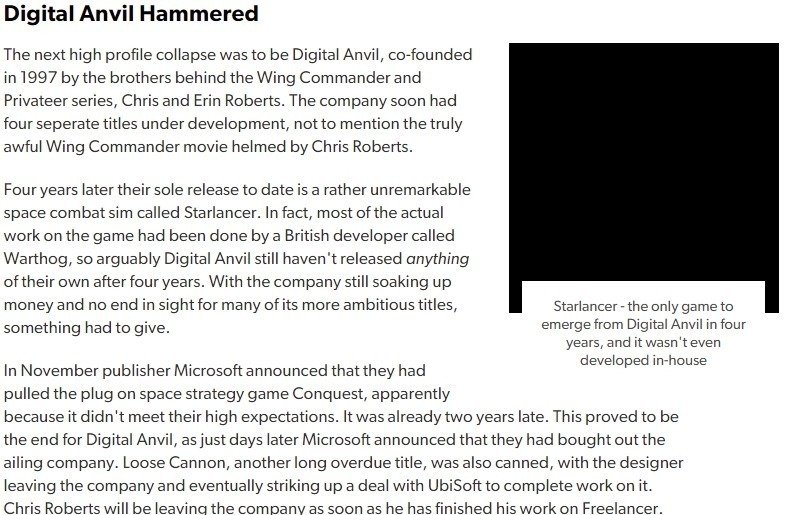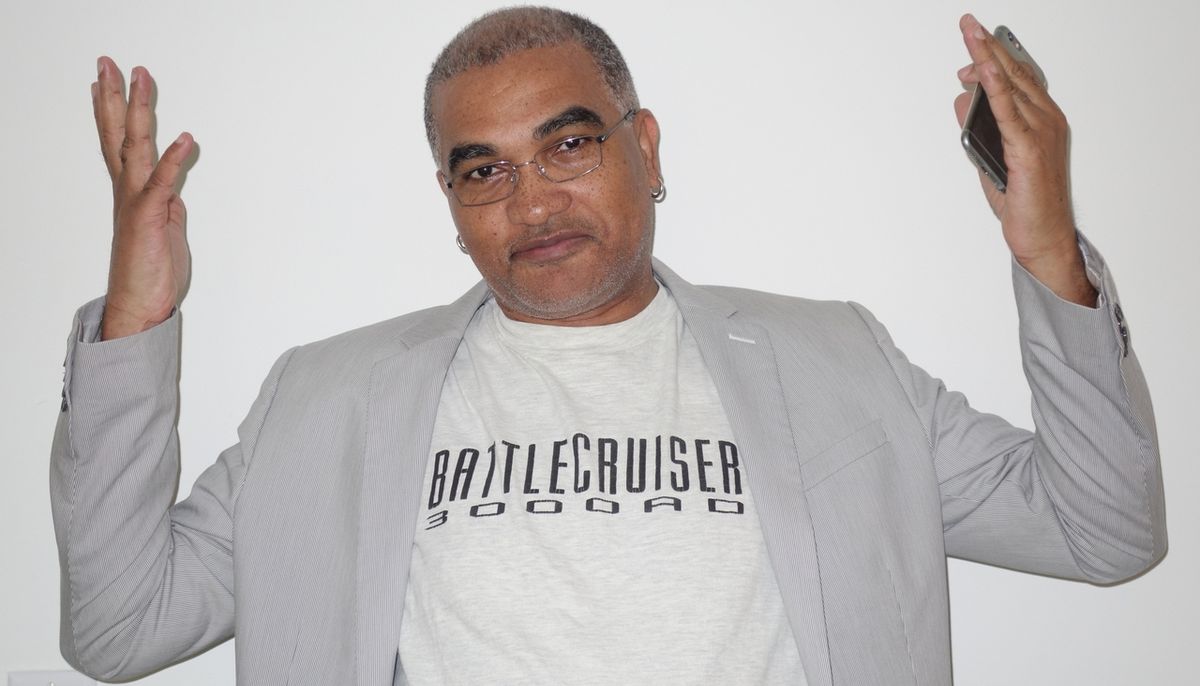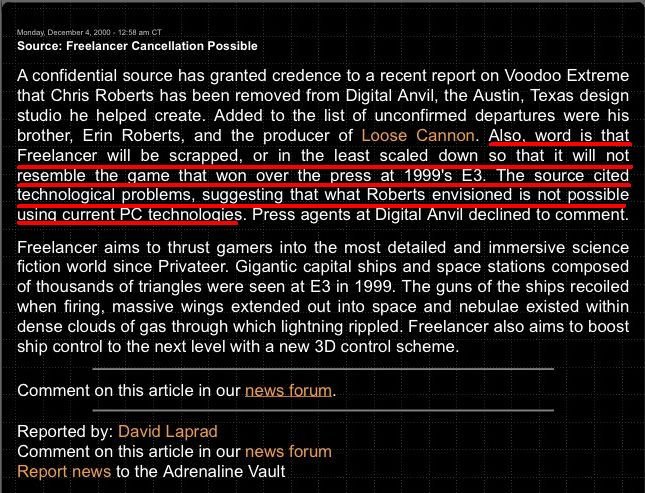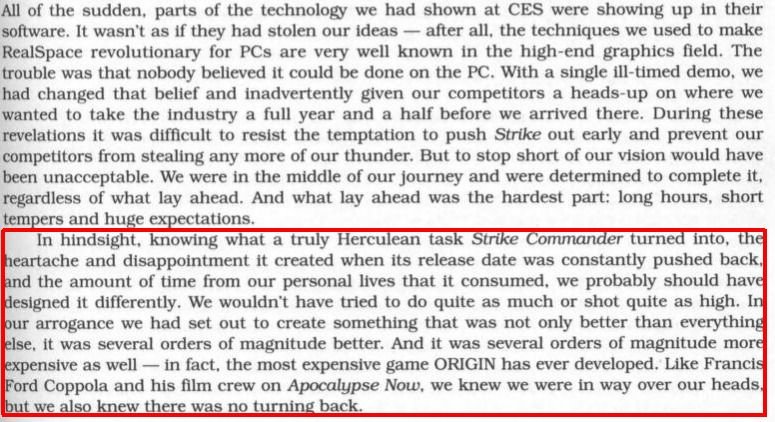THE FORESIGHT CONUNDRUM
Since July 2015 after I wrote that first blog, which initiated all-out hostilities between myself, CIG, and their cult (NOTE: I’m not talking about the backers who just want the game they paid for) minions, I have written a series of Star Citizen blogs highlighting not only all the problems with the development, but also the deceptive practices, flat-out lies, and everything in between. As I look back now, I remain astonished that not only have I been consistently correct in my analytical opinions and investigations, even as the development hasn’t made much tangible progress, but things have progressively gone from bad to worse.
In that four year span, neither the multiplayer Star Citizen nor its single-player component Squadron 42 are even near completion, the development is barely at 40% completed – and they’ve flat-out blown through all backer money.
As if that wasn’t bad enough, in Dec 2018 it was finally made public that not only had they run out of money, but they also had to go to off-shore investment sources to raise $46M in order to continue development of the projects. Back then, I wrote a blog covering that fiasco in much detail.
As development continued apace, amid the weekly dev updates and [routinely missed] quarterly build releases, it has become pretty obvious that in order to build the game promised, it would likely take another six years or more – and with their current burn rate, another $250M. That’s not funny or unrealistic when you consider that since 2012 to now, they’ve burned through that much money. After all, back in July 2015 I did say that the game Chris wanted to build would require a capable engine, team, and no less than $150M. They had raised $85M at the time. Here we are.
Since that time, it has been mostly quiet on the Star Citizen front. Following the release of the financial brochure in Dec 2018, the last of three (refunds for those who asked, dev schedule, financial accounting) things that through legal action I had pushed for, I had decided to sit back and see what came next.
Then on May 1st 2019, Forbes disrupted the lull in the farce with a bombshell article of epic proportions.
THE FORBES INQUEST
Though as far back as March I knew that it was in the works via some of my industry friends who told me one of the writers had reached out to them, I didn’t expect this to be the angle of the story. For the record, and because I live rent-free in the brains of the Star Citizen cultists who see me behind every bad news story about their train-wreck, I was neither contacted by the writers, nor had anything to do with the story – other than maybe they read some of my articles during their research since they are the only body of work which have captured this on-going fiasco in such detail.
Since the release of the article, just like my 2015 blog in which I had claimed – among other things – that the game could never be made, and the explosive article by The Escapist (which yielded the craziest public response by a CEO in modern history), the Internet denizens have been collectively aghast and agape.
But here’s the thing, controversy isn’t new to Star Citizen; in fact it has been the mainstay since the 2012 crowd-funded campaign. For a time, the project and Chris Roberts basked in the adulation bestowed upon him as if he was the Second Coming. Heck, he did start out with the rather ludicrous mantra of being “out to save PC gaming” (I kid you not) in interviews like this remarkable one in VentureBeat. In that fanboy fluff piece in which Chris claimed that the game was two years out, Dean Takahashi said: “Now that I’ve seen a demo of Star Citizen, it reminds me how much I miss those epic space battles where you save the human race from the evil aliens“. At the time, little did any of us know that what Dean was shown, and which we later found out years later, was no game demo. It was a special promo created in association with CryTek (who later sued CIG) the engine licensors. Though portrayed as the actual game, the promo wasn’t actually the game – at all. In fact, the first debut of the game to backers was in the form of a hangar module released in Aug 2013. All it did was allow you to view any ships which you had purchased. Now that I look back, it set the stage for what was to come: the selling of 2D and 3D ships as the primary fundraising exercise. The first time you could actually do any flying in the game, was when the Arena Commander flight module, was released in June 2014 – and it looked and played nothing like the 2012 “game” that was promoted. Moving on…
As I mentioned in my first Twitter threads (1, 2) after the story broke, the startling thing about the Forbes article, aside from the fact that it’s not one of their opinion pieces, and that it will appear in the May 31st print edition (approx 7M subscribers), is that it didn’t contain anything new about the on-going disaster. Not a single thing. We already knew that not only had the project scope increased beyond reasonable expectations, and would thus take longer and cost more to develop; but we also knew that Chris Roberts was up to his old tricks again, and which had led to his post Wing Commander projects ending in complete disaster. Let’s explore the key points in the Forbes Inquest.
SCOPE CREEP DISGUISED AS AMBITION
The Kickstarter debut of the project in 2012 was very manageable and doable. After telling anyone who would listen that at the time in 2012 the project was already one year in development, and was to release in Nov 2014; he went on to steadily increase the scope of the project to an astounding $65M goal. He achieved this fundraising goal the very same month that both games were to be released.
Later, as most of the sane ones among us started raising the alarm about scope creep, incapable game engines etc, Chris then justified this scope creep by claiming that the “backers voted for scope increase” via poll. Which was blatantly false, and an attempt to foolishly pin the responsibility on backers. In fact, there were two polls – neither of which did anything to suggest that he should increase the scope of the game.
The first poll on Nov 3rd, 2012 was about the stretch goals.
“As we enter the last two weeks of the pledge campaign, we’re continuing to look at ways to make sure Squadron 42 and Star Citizen are the game you want to play. To that end, we’re preparing to roll out a more comprehensive set of stretch goals… and, as usual, we would like the community’s input. What do YOU think we could plan to add to our campaign?“
Well, this was the poll result. Compare those entries to what finally ended up in the final stretch goals to $65M, and you have your answer. Pay close attention to items 1 & 2. Remember, the campaign ended that same 2012 month whereby Chris was still saying the games would be out by Nov 2014.

The second poll on Sept 16th, 2013 was about the public funding counter
“In the spirit of asking YOU what you want, we would like your input on our pledge counter and future stretch goals. What should we do with the crowdfunding counter after we reach our goal?”
This was the poll result for that one. This is the same one in which Chris Roberts proclaimed “perhaps more importantly we can apply greater number of resources to the various tasks to ensure we deliver the full functionality sooner rather than later“. Seriously.

As you can already tell, neither of those two polls had anything to do with the level to which the game’s scope increased. There were no other polls about this – ever.
Each time it comes up that the game’s scope had been increased to a level that had set the project on a course to failure, CIG and their devout cultists would trot out the “backers voted for scope increase” lie, and which they have since used as an excuse for the project’s on-going demise. They completely disregard points raised that the poll data doesn’t show any consensus or agreement in any of the options, since not even a simple majority agreed on any one option despite each participant being allowed to select three choices. They were given three votes each, and they still failed to put any of the choices above a 40% support threshold; suggesting that there was no majority support from the community for any of the stretch goal choices in the poll. As some pointed out, given three instead of one choice should have ultimately pushed any choice to 50% or higher. In the end, the poll clearly showed that CIG did the poll, ignored the results, then went on to increase the scope of the project – even beyond the poll choices! That basically negated the poll in its entirety, thus rendering it moot.
In case you were wondering, this major scope increase was one of reasons that, about two years later after some people on the team reached out to me, I ended up doing my own research which led to the 2015 July Blog.
MISSED RELEASE DATES
When both Star Citizen and Squadron 42 missed their original Nov 2014 release date, and every promised date since then, we knew that the project was not only in trouble, but was also running a higher risk of complete collapse. Heck, I’ve been sounding that alarm since 2016 when I wrote a blog saying that it had devolved into an Extinction Level Event. But despite my warnings that the project was fast running out of money, most didn’t believe me because CIG was using the public-facing funding tracker as a Red Herring to dispel any and all such rumors.
In fact, after missing the Nov 2014 ship date for both games, the excuse about making the game bigger and better because “the community asked for it”, even Squadron 42 missed every single release date. Back in 2017 when I wrote an article that sources said the dev schedule for it went all the way to 2021, some people disputed it. In their Dec 2018 financial disclosure, CIG is now claiming a Beta release for mid-2020.
 WHEN HISTORY REPEATS ITSELF, YOU TAKE NOTICE
WHEN HISTORY REPEATS ITSELF, YOU TAKE NOTICE
NEGATIVE BALANCE EQUALS INSOLVENCY
When they finally released their financial brochure in Dec 2018, it revealed that at the end of 2017, they had only about $14M left. For a project that has an average yearly budget of $40M. Even without taking into account the liabilities (not disclosed), it was clear that after raising $207M at that point in time, that the project was insolvent. Which, despite the statements about the $46M off-shore investment bailout being for “marketing of Squadron 42”, it should have been clear that they were going to be dipping into it for their on-going dev budget. I mean, it’s not rocket science – this is what the funding chart currently looks like in May 2019. Note that during that same 2017 year they took out a loan in the UK with Coutts bank, while saying that it was for tax credits. As I wrote in this blog back then, it was suspicious right from the start. Now we know.

AS OF MAY 2019 THEY HAVE YET TO RELEASE THE 2018 FINANCIALS
We also found out in the report that the monthly subscriptions which average about $12 per backer, generated about $3M in revenue for 2017. That means, of the million or so backers who paid anything to the project, not even a fraction had subscriptions. So it came as no surprise when between 2017 to now, CIG has either shutdown or trimmed all the video broadcasts which they claimed the subscriptions were paying for. These numbers also further add credibility to what we’ve known for years: a handful of whales have been propping up this train-wreck in a sordid display of sunk cost fallacy.
INCOMPETENCE & MISMANAGEMENT
We’ve known about this throughout Chris Robert’s career. And the revealing 2015 David Jennison memo (which I covered in a 2015 blog and again in a 2017 recap) solidified the notion that he was up to his old tricks again. As I recently wrote in a long Twitter thread with various legacy references, none of this is new or news. The Chris Roberts Theory Of Everything has led to a history of repeated failure through mismanagement and incompetence which have plagued his entire career since he moved on from Wing Commander. It was neither a secret nor was it ever in dispute.
While Star Citizen is heralded as the largest crowd-funded anything in modern history, even as that success is credited to the unknown non-entity that is Sandi Gardiner just because she held the VP of marketing title, the unsung heroes are Turbulent (their CMS white-paper), the Canadian company that was largely instrumental in that success. Basically, the crowd-funding was a success, even as the projects it was meant to fund, and which were steered by Chris Roberts, have devolved into an unmitigated disaster. It’s basically the same scenario whereby a publisher would fund Chris Roberts’ project, which he then ran into the ground. Except this time around, the funding party are the backers and investors who are unable to hold him accountable for any of it.
Ponder this. In 2012 Chris Roberts tried to crowd-fund $2M to build two games via the original website, then Kickstarter, then on their new website (built by Turbulent). He got $7M. Then $20M. Then, after the scope-creep dust had settled in Nov 2014, he got $65M. As of this writing, almost five years (this Nov) later, and approximately $235M over budget (using the $65M figure), he has yet to build even the original game for which he was asking $2M. Seriously, that’s where we are now.
THE ROAD LESS TRAVELED
Despite my opinions on this train-wreck, I took issue with the personal things in the article. Once again, while none of it is new to most of us, I felt that it detracted from the core of the article. Some have opined that for a company like this, as well as it being crowd-funded, that those events make it more relevant as they are also husband and wife. That being the case, here’s the thing. That Sandi Gardiner is portrayed in court records as an abusive stalker, and that they’re apparently in a dysfunctional marriage, is not as relevant as the fact that for years she – as a senior exec in a multi-million Dollar crowd-funded project – lied about having not one, but two business degrees, has been horrid to employees, contractors, and backers etc. And this was during the same period when they were making efforts to keep their marriage hidden (it was, until I blew the whistle on that one in 2015). Even back when she was accusing myself and irate backers of harassment – a ploy that failed the minute she thought of it – and which prompted me to writing this scathing blog about her in 2016, I still didn’t think such personal matters were relevant to the big picture.
Years ago as a backer and vested party, not only did I hire investigators (as I did attorneys) to get to the bottom of some of the things I was hearing, but for a time, we were playing whack-a-mole with all her statements and LinkedIn revisions (1, 2, 3). We’ve had access to records not only here in the US, but also in her home country of Australia; but never disclosed them because I didn’t find most of them relevant. Even when, after re-tweeting an IMDB link, and also pointing out that they had used backer money to move into a mult-million Dollar house in Pacific Palisades for which they accused (complete with legal threats) me of stalking and doxing, I still didn’t think that releasing that sort of damaging personal information was OK.
But here’s the thing. If during an investigation of a fraudulent enterprise and it’s execs, damaging personal information is uncovered, that usually ends up being news. For the latest example, look no further than the Theranos fiasco; or even the Fyre Festival. However, in the case of Star Citizen, that the project is mismanaged, rife with incompetence and bad decisions, that the execs are habitual liars etc, doesn’t rise to the levels (e.g. of fraud) which would warrant that sort of exposé. Like most, I’m more interested in knowing whether the executives of the company running the project are honest, have integrity, are capable of delivering on promises, aren’t wasting or stealing backer money etc. While it’s been proven time and time again that the top CIG execs running the project don’t have any of the aforementioned qualities, I’m not sure that I care whether or not Sandi Gardiner is a stalker, domestic abuser, or whether or not one of her last work gigs – as alleged by numerous Internet anecdotes – was in a tickle fetish studio. I mean, since as far back as 2014, even those who ended up being staunch supporters of the project, were questioning her abilities and qualifications. To the extent that even back then, as more questions kept being asked, they even removed the Meet Sandi Gardiner profile (archive) from their own website!
When Chris, after squandering backer money to the extent that unjust enrichment set the project on a path to insolvency, then goes on the record and says that money used to buy a $4.7M house came from past previous wealth, aside from being blatantly false, it should be alarming in and of itself. Why? Because for all the money raised, and all the time spent, he has yet to release a single game – of any kind. Some of us know that he has been broke since Ascendant collapsed, that he bounced from one gig (in one period, he was selling exotic cars) to the next, while landing as recently as 2010 at yet another defunct company, Blink Media as I reported here. He lied. Now ask yourself this. Why would he lie if there was nothing to hide? Because it’s bad optics. If Forbes had hired a private investigator, they would have uncovered the same things that some of us have known for years now. Having spent 2010-2011 shopping the project around and getting no takers, Chris was broke going into Star Citizen in 2012. Then, following the crowd-funding windfall, they moved into the Pacific Palisades house which had rent as high as $16K per month by some accounts. In fact, it was when I uncovered this and wrote about it in 2015, that they threatened me with legal action for stalking and doxing. And then, shortly after closing a $46M bailout in May 2018, they started working on buying this $4.7M home in the same Pacific Palisades area, closing on the sale several months later in Sept 2018. And note, they never publicly disclosed this bailout to backers until Dec 2018 – one year after their own financials showed that the project was insolvent in 2017.
As I mentioned in yet another recent Twitter missive, these are the relevant issues because it all boils down to what happened to backer money. I gave an analogy that backers who keep giving the project money are akin to church congregants who can barely make rent, but have no problems giving the church money every week so that the preacher can live a lavish lifestyle in a multi-million Dollar home, drive fancy exotic cars etc.

REFUNDS REDUX
This one angers me the most. Forbes took Chris’s word about refunds, and that its 30 day refund policy is generous etc. Here’s the thing: in the beginning, you could get a no-questions-asked refund if you wanted one, or if the project wasn’t delivered within a certain (12, then 18 months) period of time from the Nov 2014 release date. It was in the ToS. Once things started slipping and some backers began to ask for refunds, guess what CIG did? They changed the ToS, not only to completely remove refunds past 30 days, but also to say that – for all the millions raised – they don’t even have to deliver a game of any kind. I’m not even kidding. As I wrote back in this 2016 blog, it wasn’t long before Chris then went on the record and said that game he promised would be released as a minimum viable product instead of the complete product he raised millions of Dollars to develop. Over the years I’ve written extensively about this; the last one is in my year six blog coverage which outlined all the ToS changes.
BUILDER OF WORLDS
As shocking as it to some to learn that seven years later not a single starsystem in the game’s massive world has been released, it’s not exactly news. I mean, come on, they promised 106 starsystems when they had raised $65M. For years I had stated that there was no way in hell they were going to build that; especially not with that engine. That they don’t even have a single one complete seven years later, should come as no surprise.
I recall back when they were lying to backers and stating that procedural tech would make them create the rest of the world much faster. This was not only a smoke screen because no such procedural tech exists in their toolset, but it was yet another blatant display of lies to keep misleading backers. In a 2018 article, I wrote an extensive article explaining why these were all lies. It’s now May 2019, and according to the dev schedule by the end of 2019 – assuming it doesn’t slip – when Microtech planet is released, it would mark the only starsystem to be created. The first planet, ArcCorp, debut in the 3.0 build back in Dec 2017. Well, do the math.
If you’re wondering how Squadron 42, which relies on the same game world, is going to be in Beta by mid-2020, well, we don’t know either. Either it’s going to take place in that single starsystem, or they have created smaller scenes and levels specifically for that game. I mean, the scene you see in the 2018 Squadron 42 trailer below doesn’t actually exist in the Star Citizen game world. It’s yet another promo demo built specifically to give the illusion of progress.
THE FORBES FALLOUT
The most glaring aspect of this Forbes article, aside from it not containing anything new regarding this train-wreck, is that now dozens of outlets have picked up the story and are putting their own spin on it. And some of these are by the same writers who have known these past years that something was terribly wrong, but they still kept on writing various shill pieces, regurgitating bs marketing material from CIG etc. All of a sudden, the likes of Forbes writes a litany of words about things most already knew about, and suddenly everyone is on the bandwagon regurgitating stuff they already knew and/or were thinking, but too chicken to commit to words. From Variety to Metro-UK, to gaming media such as Nichegamer and PCInvasion, and most mainstream or fringe news site you never heard of before, everyone is now carrying the story. Even the guys at Den Of Geek who don’t normally cover our industry, are expressing amazement. We saw the same thing happen when The Escapist article did a similar story months after my first blog hit back in 2015. As expected, they too got their share of legal threats from CIG.
It’s not as if CIG is going to do what they tend to do: try and scare Forbes with a legal threat. I’m sure they would try because, you know, Ortwin is bat-shit insane.
Nothing will change the course of the project’s demise. The project is well on its way to its inevitable collapse, and only Chris Roberts and his friends and family would have benefited from a years long endeavor to build a game they knew with certainty they couldn’t build as promised. And even when the dust settles, as David Piner wrote in his latest (read his 2013 version) alarming article, those acting like they’re in a cult will no doubt find a way to spin the whole thing, even as Chris once again rides into the sunset of yet another failure.




